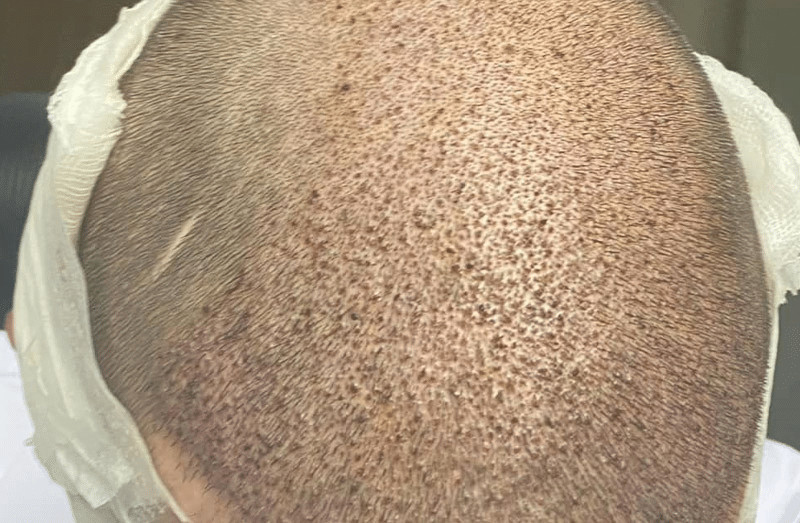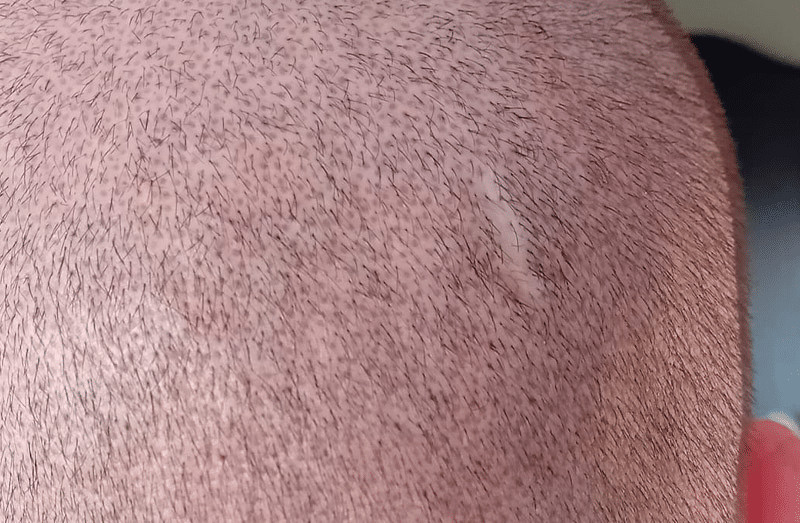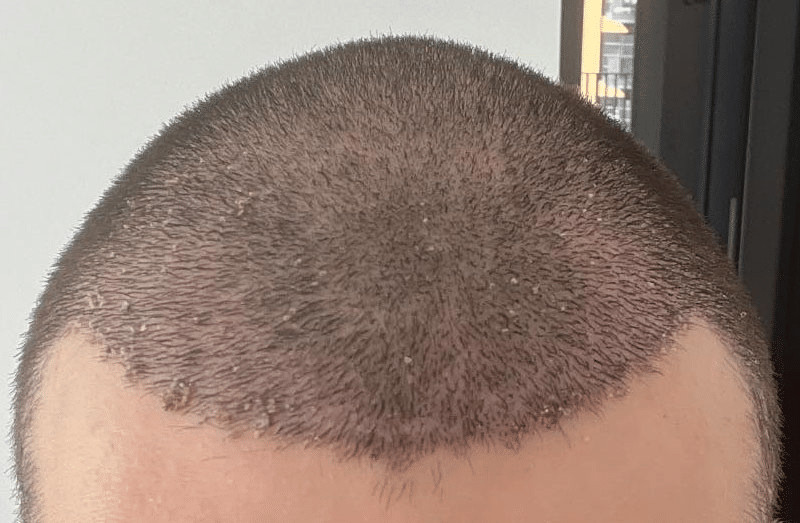If you have a scar on your head and are considering a hair transplant, you may be wondering if the hair will successfully take root and grow. The answer is yes, thanks to advancements in hair transplant surgery.
In the past, it was believed that hair could not grow on scar tissue. However, with techniques like FUE (Follicular Unit Extraction), hair can now be transplanted into scars and successfully grow.
Yes, Hair Transplants Can Grow on Your Scar
According to hair restoration surgeon Dr. Shelly Friedman, as long as the donor hair or hairs have follicles (roots), they can be transplanted into a scar and will grow. This is great news for those who have scars on their scalp and want to regain a full head of hair.
However, it’s important to note that transplants into scars may require multiple treatments and extra care from the surgeon due to scar tissue having a reduced blood supply.
Also, the number of grafts raised scars that can be placed on scarred skin may be limited and they must be placed further apart. This means that multiple treatments may be necessary to reach the desired level of density.
What is it Like to Transplant Hairs Into a Scar?
Some scar tissue may be thicker than usual, making it more difficult to operate on. In these cases, steroid treatments can help smooth and flatten the scar tissue before the next hair transplantation surgery is performed.
Aftercare is also crucial for successful hair transplants on scars. It’s important to avoid touching the grafts for at least a week after surgery, and your surgeon may recommend a special aftercare spray to aid in the healing process.
Also, it’s important to choose a qualified and experienced hair transplant surgeon who can properly perform hair transplant scars and the procedure on scars.

About hair transplants on scar tissue
Hair transplants on scars can be life-changing for those who have been living with noticeable scars on their scalp. It’s important to do your research and find a reputable hair transplant surgeon who has experience in hair restoration surgery and transplanting hair into scar tissue.
After the procedure, you can expect some redness, swelling, and scabbing around the transplanted area. This is normal and will subside within a few weeks.
Plus, after 6 months, you can expect to see hair growth in the transplanted area. However, it may take up to a year for the full results to be visible.
What’s the procedure like?
The follicular unit transplantation procedure for scars is similar to a regular FUE or hair transplant procedure. The surgeon will harvest healthy hair follicles from the donor area (usually the back or sides of the head) and then carefully transplant them into the scar tissue.
The difference with scar tissue is that it may require more precision and attention, as well as multiple treatments. It’s important to have realistic expectations and follow your surgeon’s aftercare instructions for the best results.
What type of scarring can be treated with a hair transplant?

Hair transplants can be used to treat various types of scarring including:
Traumatic scars from accidents or injuries
Surgical scars from previous procedures on the scalp
Burn scars
Scars from previous hair transplants that did not heal properly
If you have a scar on your scalp and are considering a hair transplant, consult with a qualified surgeon to see if you are a good candidate for the procedure. With proper care and multiple treatments if necessary, you can expect to see successful hair growth in the transplanted area after 6 months. Don’t let a scar hold you back from having a full head of hair – explore your options with an FUE hair transplant today!

Can having an FUE Hair Transplant leave scars?
One of the benefits of an FUE hair transplant is that it leaves minimal scarring. As opposed to traditional strip harvesting methods, which leave a noticeable and visible scarring on the back of the head, FUE uses individual grafts from the donor area without creating a linear scar or incision.
However, if you are undergoing multiple treatments or have scar tissue present on your scalp, it’s important to communicate with your surgeon about the possibility of scarring and how it can be minimized. With proper care and a skilled surgeon, you can minimize any potential scarring and achieve natural-looking hair growth in the transplanted hair area.
Can I cover my FUT scar with another hair transplant?
If you have a noticeable scar from a previous FUT hair transplant surgery, it is possible to cover the scar with hair plugs with another procedure using the FUE method. By harvesting individual grafts and placing them strategically over the scar tissue, your surgeon can help blend in the scar with natural-looking hair growth.
However, it’s important to consult with your surgeon about realistic expectations and whether or not the new hair transplant will fully cover the scar. It may require multiple treatments and proper aftercare to achieve the desired results.

How Do You Hide a Scar on Your Head?
If you have a noticeable scar on your head and are looking for ways to hide it, there are several options available. The best option will depend on the severity and location of the noticeable scarring, as well as personal preference.
One way to hide a scar is by using hair styling techniques. For example, if the scar is located near the hairline or on the scalp, you can use hairstyles that provide coverage, such as long side-swept bangs or a textured, layered cut. You can also use hair accessories like hats, scarves, or headbands to cover the scar.
Another option is makeup. There are special concealers and powders designed specifically for covering scars and discoloration on the skin. These products can help minimize the appearance of scars and blend them in with your natural skin tone.

Scar Revision FUE Surgery
In some cases, scar revision FUE hair transplant surgery may be an option. This involves surgically altering the hair transplant scar line or the appearance of the scar to make it less noticeable. However, this option may not be suitable for everyone and should be discussed with a qualified surgeon.
Hair transplant procedures can also help hide scars on the scalp. By transplanting hair follicles into the scar tissue, your surgeon can help blend in the scar with natural-looking hair growth. This option may require multiple treatments and proper aftercare for optimal results.
Lastly, if you are comfortable embracing your scar, there is no need to hide it. Many people choose to embrace their scars as part of their unique story and identity. However, it’s important to do what makes you feel confident and comfortable in your own skin.
The Science Behind Scar Removal Hair Transplants
Scar removal graft hair follicles transplants, also known as scar revision surgery or hair grafting onto scars, involves surgical removal and transplanting hair follicles into scar tissue to help minimize the appearance of a scar.
During the procedure, healthy hair follicles are extracted from the donor area and then carefully placed into the scar tissue. These now transplanted follicles and hairs will continue to grow naturally in their new location, helping to blend in the scar with surrounding hair growth.

Stem Cells & Hair
The reason this method works is due to the unique properties of individual hair follicles. Hair follicles contain stem cells that have the ability to regenerate and continuously grow new hairs. When transplanted into a scar, these stem cells can help stimulate tissue regeneration and promote healing of scar formation.
In addition, hair follicles also produce sebum, a natural oil that helps keep the skin of healthy skin, and hydrated. By transplanting newly grafted hair follicles into a scar, the surrounding tissue can benefit from this sebum production and improve the overall appearance of the scar.
Scar removal hair transplants have been shown to be effective in treating various types of scarring including burns, surgical scars, and even previous no hair transplant scars without scar. The success of the procedure will depend on the individual’s skin type and the severity of the scar.
Proper Aftercare is Vital for Success
Proper aftercare is crucial for optimal results. Your surgeon will provide specific instructions on how to care for your scalp after the procedure, including when to wash your hair and when to avoid any strenuous activities or sun exposure.
Following these instructions can help minimize scarring and promote healthy hair growth in the transplanted area.
Contact Best Hair Transplant
At Best Hair Transplant, we understand the impact that hair loss and scarring can have on a person’s self-esteem and overall well-being. That’s why we offer advanced FUE hair transplant procedures to help our patients achieve natural-looking hair growth and boost their confidence.
If you are considering an FUE hair transplant or have any questions about the procedure, please don’t hesitate to contact us. Our experienced and skilled team is dedicated to providing personalized care and helping our patients achieve their desired results.

